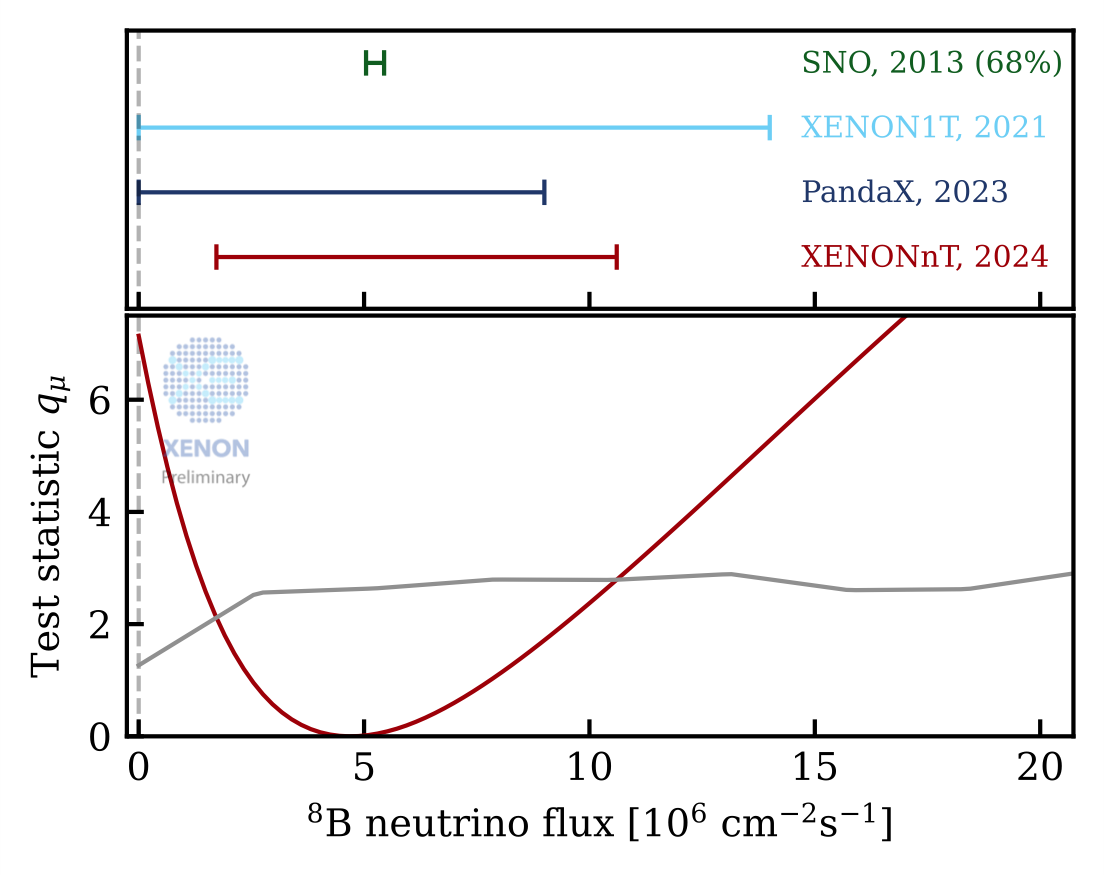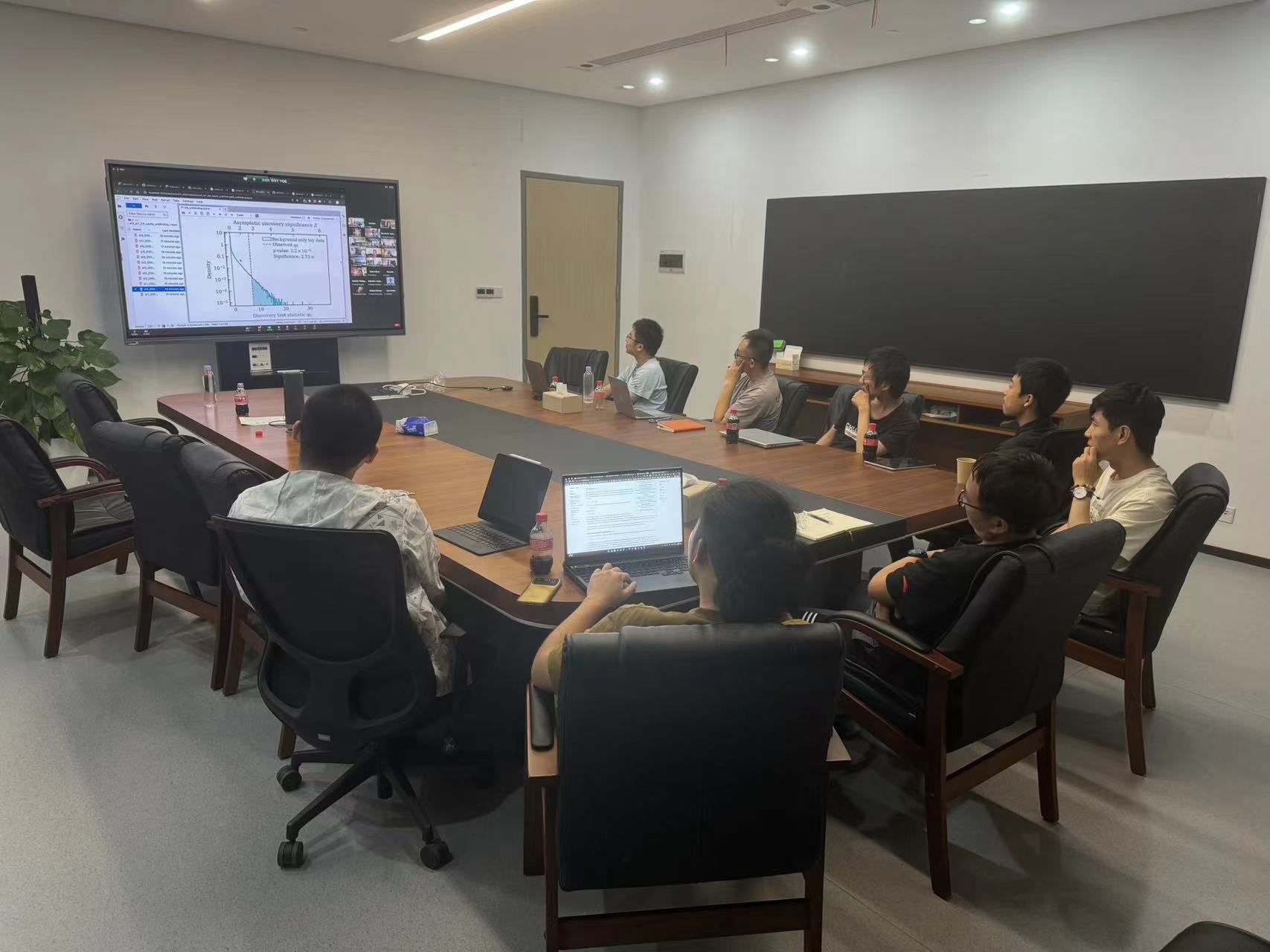On Wednesday, July 10, at the IDM conference in L’Aquila, Italy, the XENONnT collaboration announced the first measurement of low-energy nuclear recoils from neutrinos produced by nuclear reactions inside the sun.

Figure 1 The observed signal can provide a bilateral confidence interval for solar neutrinos
Alongside hypothetical dark matter particles, neutrinos from the sun have long been predicted to be observable in detectors built to search for dark matter nuclear recoil signals when these detectors reach sufficient “exposure” and “sensitivity”. Exposure means how long we waited and how much material we have used to observe particles. Sensitivity is about how good we are at detecting the tiniest particles. Observing this feeble signal, with energies barely detectable in liquid xenon time projection chambers like XENONnT, requires excellent detector performance and sophisticated signal-to-background discrimination methods. The measurement confirms the understanding of the lowest-energy signals in XENONnT.
XENONnT is a direct dark matter search experiment located deep underground at the INFN Laboratori Nazionali del Gran Sasso (LNGS) in Italy. Representing one of the most advanced underground research facilities worldwide for particle physics and astrophysics, LNGS provides a unique environment that significantly reduces cosmic radiation. Operating the family of ever more sensitive experiments of the XENON program at LNGS has been critical for the success of the program.
Designed to be sensitive to rare interactions of potential dark matter candidates, XENONnT’s central detector is a dual-phase time projection chamber (TPC) with 5.9 tonnes of ultra-pure liquid xenon as active target. To achieve cutting-edge performance, the XENONnT experiment employs several advanced subsystems, such as cryogenic plants to maintain the liquid xenon at the necessary low temperature, an online cryogenic distillation column for the active removal of radioactive elements diluted in the xenon, and advanced slow control and data acquisition systems. A 700 tonnes water tank featuring active Cherenkov neutron and muon veto systems surrounds the XENONnT TPC to further reduce the background.
Neutrinos from the Sun can interact with the nuclei of the xenon atoms in the XENONnT target via coherent elastic neutrino-nucleus scattering (CEvNS). This Standard Model process, first predicted in 1974, has been challenging to observe due to the very low energy recoils involved and the elusive nature of neutrinos. Only in 2017, the COHERENT experiment reported the first observations of CEvNS with higher energy neutrinos from the Spallation Neutron Source in Oak Ridge, Tennessee. Now, XENONnT is the first experiment to measure CEvNS from neutrinos produced in the core of the sun, and to measure the CEvNS process with the element xenon. XENONnT thus joins the list of famous solar neutrino experiments, which typically require 10-500 times larger detector masses.
XENONnT's low-energy detection capabilities and ultra-low background environment have enabled this first measurement. The analysis used data collected over two years, from July 7, 2021, to August 8, 2023, for a total exposure of approximately 3.5 tonne-years.An excess of low-energy nuclear recoil events over the expected background was measured, compatible with a signal from solar boron-8 neutrino interactions, with a statistical significance of 2.7 sigma, meaning that there is about a 0.35% chance that the observed signal is due to background noise. The result was obtained through a blinded analysis, meaning that the signal region remained obscured from the view of the scientists until all analysis steps were fixed to avoid human bias. This marks the first measurement of CEvNS from an astrophysical neutrino source. Moreover, such a significant result opens a new chapter in the direct dark matter detection field: XENONnT started exploring the so-called neutrino fog, where neutrino interactions are becoming a background that can mimic dark matter signals.

Figure 2 Westlake Group attending the data-unblinding ceremony for the B-8 analysis
As XENONnT continues to gather more data, the collaboration is looking forward to exciting discoveries in the realm of astroparticle and nuclear physics.
The physics team led by Shengchao Li from Westlake University has joined the international XENON dark matter collaboration as the group responsible for detector calibration. In the XENONnT experiment aimed at detecting solar boron-8 neutrinos, Dr. Shengchao Li led an international team to conduct calibration research on the neutrino-nucleus recoil signal.Using photoneutrons generated from a yttrium-beryllium source, this study identified the signal characteristics of nuclear recoil at low momentum transfer in liquid xenon, providing a basis for understanding the weak neutrino signals near the detector's sensitivity limit, and making a notable contribution to this breakthrough achievement.
For more details on the XENONnT experiment, please visit the XENON official website or contact the collaboration directly.
Contact Information:
XENONnT Collaboration
Website: https://xenonexperiment.org/
Email: xe-pr@lngs.infn.it

